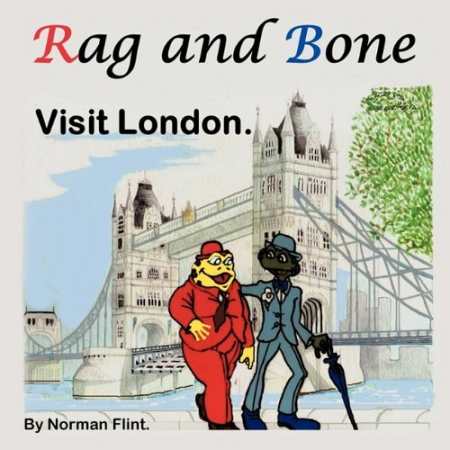Rag and Bone
Visit London
Rag and Bone: Visit London, by Norman Flint, is a cheery children’s story that follows a frog and a toad as they tour London together.
The bright colors and bold illustrations will quickly earn the attention of very young children as this story is read aloud to them. Red, blue, and yellow are used in abundance, as are bright greens and orange. Rag the toad is colored a bright yellow with a vibrant red suit, while Bone, the emerald-green frog, wears a sky-blue suit.
In contrast, the historic buildings of London are rendered in neutral shades. The delicate lines of the historic places and the almost cartoon-like characters will help children to gain a sense of what is real and what is imaginary.
Flint uses poetry to tell his tale. His words rhyme well though, in most cases, the line breaks do not correspond to the operative rhyming word, which can lead the first-time reader to stumble over pacing. Many pages offer delightful turns of phrase. For instance, “Hog shook his head to the question / and said; in a voice that was full of / good cheer. ‘I’m sorry I don’t, it’s not / that I won’t for you see I don’t live / around here.” The words “head” and “said” and “cheer” and “here” will easily catch young children’s ears, but ending each line with those words would have helped.
Unfortunately, this book also has some pitfalls. There are a number of misspellings, missed punctuation, and spacing issues. In a book with few pages and words, such errors are especially glaring. For instance, in the lines cited earlier, a comma rather than a semicolon should follow the word “said.”
Sometimes it seems as if the poetry is forced at the expense of sense. For instance, Flint writes, “He took them to Aldwych then on / to St. Paul’s, totting and ringing his / bell. Then, Trotting and totting they / went around Wapping Shadwell and / Aldgate as well! The meaning of the word “totting” doesn’t seem to fit here and the repetition of a poorly chosen word makes the entire set of lines seem forced.
If the intended audience for Rag and Bones is American children, extensive explanation would be required to contextualize many of the historic names and places Flint mentions. As such, this book provides a lively springboard for a discussion about history and geography, but, on its own, it is insufficient as an educational resource. In addition, no illustrator is listed on the cover, copyright page, or about the author page. The artwork in the book is certainly worthy of attribution.
Flint’s book will be entertaining for very young children. However, its pitfalls will prevent Rag and Bone from becoming an enduring classic.
Reviewed by
Emily Adams
Disclosure: This article is not an endorsement, but a review. The publisher of this book provided free copies of the book and paid a small fee to have their book reviewed by a professional reviewer. Foreword Reviews and Clarion Reviews make no guarantee that the publisher will receive a positive review. Foreword Magazine, Inc. is disclosing this in accordance with the Federal Trade Commission’s 16 CFR, Part 255.

